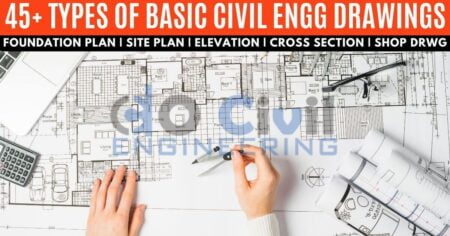Safety Requirements for Formwork
There are a few things that a formwork structure needs to be able to do before it can do its job well. To ensure that the form structure meets its design goals, the designer and site engineer should consider the structure’s technical, functional, economic, and safety needs.
If these requirements are met, the formwork structure will be safe, strong, and robust, and workers will have a safe workplace. The formwork is a temporary mould filled with fresh concrete and reinforcement to make a specific reinforced concrete element. It holds up part or all of a permanent structure until it can stand independently.
Technical Requirements of Formwork
- Formwork should be the right shape, size, and fit where the member in the structure is supposed to be, as shown on the drawings.
- It should be carefully chosen based on the finished surface and linings needed to make the desired concrete surface.
- Formwork needs to handle the pressure of fresh concrete and working loads, and it shouldn’t bend or move while concrete is being poured.
- When the formwork is taken off the structure, it must not damage the edge or surface of the concrete or itself.
- The formwork panels should fit together tightly to keep cement paste from leaking out of the formwork joints.
Functional Requirements of Formwork
- The size of the formwork sections should make it easy to lift and move them from one job site to another. It should be as easy to take apart and move as possible.
- Formwork units must also be able to be switched out with other ones. This lets units be used to make different kinds of members.
- Formwork must be made so that it fits together and locks together with a reasonable amount of ease.
- Another essential functional requirement of forms is that they are easy to assemble. The weight of the formwork should be kept as low as possible without sacrificing strength.
Economic Requirements of Formwork
- Cheap materials will be used to make the forms.
- The amount of energy used and the cost of labour should be as low as possible.
- Using formwork more than once is another economic need that can’t be sacrificed. So, they must be able to be used more than once without getting out of shape.
- The structure of the formwork must be made so that it can be put together and taken apart by people with little or no training.
- Maintenance of formwork must be done according to the standards in place.
Safety Requirements of Formwork
- Formwork needs to be made to make it safe for workers to move it around.
- Health, safety, and hygiene rules should be considered when making forms.
- The whole structure should be checked and made sure to be stable to avoid accidents that could kill people, slow down construction, and cost more money.
- There must be a way out in case of an emergency.
- A plan for what to do in an emergency needs to be made.
- All reasonably possible steps should be taken to eliminate any risk that could be caused by the work
- that needs to be done.
- If it’s impossible to eliminate the expected risk, control measures and safe work procedures should be implemented to minimize and control it.
Advantages of Plastic Formworks in Concrete Construction
Formworks use a lot of labour and add to the total cost of a project. Because of this, efforts have been made to create a cost-effective formwork system that can be easily put together, taken apart, and moved by labour. Plastic formworks have several benefits when building with concrete:
- Cost effective
- Labour friendly
- Eco friendly
- Low maintenance
- Versatile
Plastic Formwork System
It is made of a particular grade of plastic so that poured materials don’t stick to it, and there are no chemical reactions between the sprayed materials and the plastic form. This means there will be no patch on the surface of the reinforced concrete element. Because all of the parts of the system fit together perfectly, water or freshly poured concrete won’t leak out of different parts of the form. Also, it is the most labour-friendly system because it is easy to fit together and plugin, and it is much lighter than other formwork systems.
Before pouring concrete, there’s no need to nail or oil the plates because the plugging system has an auto-levelling feature that makes the leaves level themselves. As a result, it takes about 30% less time to set up and take down than conventional form systems. Also, the plastic forms are easy to clean with water after use, and if they break because of bad handling, they can be fixed with a low-voltage hot air gun. Other materials for formwork, like wood, steel, and aluminium, have different drawbacks that may outweigh their benefits. For example, using wood is very expensive and has big effects on the environment because it leads to trees being cut down. Aluminium formworks can be used many times, but they are only sometimes the best choice because they are costly.
On the other hand, plastic forms can be recycled, which is good for the environment, saves time, and has a high reusability index. Table-1 shows how plastic states compare to other types of forms. Table-1 shows how plastic, traditional, and steel formworks compare.
